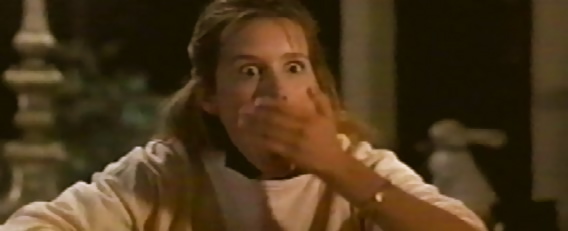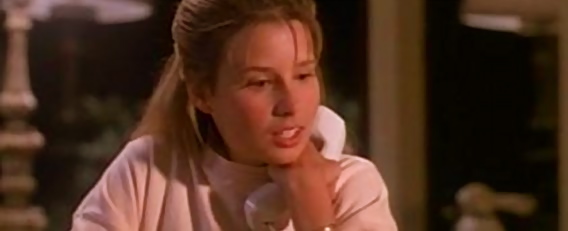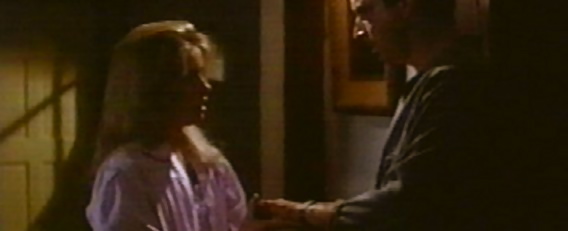
The practical joke gone wrong, such a staple of the slasher film. Hell Night, The Burning, Slaughter High – a common device within the genre is justifying the killer’s motives by using the prank as a catalyst, in an attempt to create sympathy and humanise the antagonist. It gives the audience some light humour, creates an interesting set piece with which to open the movie and provides the villain with a suitable backstory, thus giving meaning to their rampage of terror. Which film in particular created this cliché if up for debate, but the gimmick can be traced back as far as 1965, when cult filmmaker William Castle directed the Joan Crawford thriller I Saw What You Did, in which two teenage girls pull a prank whilst babysitting that attracts the attention of a man who believes they were witness to him murdering his wife. In 1988, as the slice ‘n’ dice cycle had slowly ran its course, director Fred Walton, fresh from his minor success with the postmodern slasher April Fool’s Day, decided to resurrect the story for Universal TV with a cast that included future scream queen Shawnee Smith (Saw) and Tammy Lauren, one decade removed from her starring role in Wishmaster.
The genesis for the story originated back in 1964 when mystery writer Ursula Curtiss penned a novel entitled Out of the Dark. Her thriller was based around a group of young girls who are left under the care of a babysitter in their isolated country home whilst their parents are out for the evening. But the babysitter cancels and fourteen year old Libby is forced to be the parental figure for her younger siblings. Kit, her new friend, suggests a game in which a number is called at random and the line “I know who you really are and I saw what you did” is uttered. But, unknown to them, the number that Kit has called belongs to a sociopath who becomes paranoid that his murderous deeds had been witness and so sets out to hunt the girls down. The following year, Castle teamed up with screenwriter William P. McGivern to bring the story to the screen as I Saw What You Did, which saw teenagers Sara Lane and Andi Garrett attempting a similar prank, only to attract the attention of John Ireland, a man who has recently murdered his wife and will keep hos crimes from being discovered at any cost.
By 1988, Walton had enjoyed almost a decade of success within the industry. Having made his first short film, The Sitter, in the late seventies, he had expanded the premise into his feature debut When a Stranger Calls in 1979, a movie which became a cult favourite and terrified a generation of babysitters. After several episodes of the acclaimed television series Alfred Hitchcock Presents in the mid-eighties, Walton returned to the big screen with April Fool’s Day, a tongue-in-cheek panache of the slasher genre which attempted to breathe new life into the formula that had been created by the likes of Friday the 13th several years earlier. But audiences didn’t get the joke and the film was not the success Walton or Paramount had hoped and so the director retreated back to television territory with a new adaptation of I Saw What You Did.
Funded and produced by Universal, who had originally acquired the rights to Curtiss’ novel for Castle back in the sixties, the story would be reworked by first-time screenwriter Cynthia Cidre. Born in Cuba, Cidre moved to America in 1967 and spent most of her childhood in a Cuban region of Miami. Having flirted with the idea of becoming an English professor whilst studying at university, her interest in writing was fuelled when she won a screenwriting competition that her lecturer had unknowingly submitted for. The prize saw her relocate to Los Angeles under the wing of Columbia Pictures to write her first script, a story inspired by her upbringing called Little Havana. The story would eventually be shot in 1991 under the name Fires Within with L.A. Law star Jimmy Smits, but not before Cidre had penned a script for Universal TV.

There were a few notable differences between Cidre’s adaptation and the one penned by McGivern in 1965. In place of Libby Mannering and Kit Austin (Garrett and Lane, respectively), the two protagonists had become Kim Fielding and her new friend, Lisa Harris, who have been left in charge of Libby’s younger sister, Julia, whilst their parents are out. As the evening becomes tiresome, Kim suggests calling someone which inspires Lisa to play a game. They begin phoning random numbers and eventually play the prank on Adrian Lancer, a failing motion picture musician who has recently been fired and dumped by his girlfriend, before lashing out and murdering her. After being witnessed burying her corpse in the woods, Adrian is paranoid that his crime will be discovered and becomes convinced that Kim knows the truth when she calls his house claiming “I know what you did and I know who you are.”
The cast which Walton would assemble for the picture would consist of a selection of actors who were more than familiar with television work. For the part of Kim, the producers settled on seventeen year old Shawnee Smith, a native of South Carolina where she had made her acting debut at the age of nine in an advert for McDonald’s. Her feature debut was in 1982 adaptation of Annie, which led to roles in the likes of Iron Eagle and All is Forgiven, before later finding success with her excellent turn as the cheerleader heroine of Chuck Russell’s fun 1988 remake of The Blob. Tammy Lauren, who was two years older than her co-star, had previously appeared alongside Smith three years earlier in the TV movie Crime of Innocence, in which the pair had played two teenagers who spend the night in jail after committing a minor offence, only to be abused which results in Smith’s parents attempted to take the legal system to court. Lauren would follow up I Saw What You Did with another made-for-television feature, Desperate for Love, starring a then unknown Christian Slater.
In the role of Adrian, the mysterious stranger which Kim is at first attracted to until he begins to display peculiar behaviour, the studio settled on Robert Carradine, then most famous for his recurring role as Lewis Skolnick in the Revenge of the Nerds franchise. His older half-brother, David Carradine, star of cult show Kung Fu and later of Quentin Tarantino’s double feature Kill Bill, would also appear. For Julia, Walton eventually settled on eleven year old Candace Cameron (now known as Candace Cameron Bure), whose prior credits included roles in St. Elsewhere, T.J. Hooker and John Hughes’ bratpack comedy Some Kind of Wonderful. His crew was as equally talented, with Woody Omens, who would frequently work as a cinematographer on Eddie Murphy movies (such as Coming to America and Harlem Nights), lensing the film and Wes Craven’s editor, Richard Bracken (Swamp Thing, The Hills Have Eyes Part II), cutting it.
Filming commenced in late 1987 and was wrapped by the ending of the year for its CBS/Universal première on May 20 1988. The film received favourable reviews and would go on to win an Emmy Award for ‘Outstanding Cinematography for a Miniseries or a Special.’ After I Saw What You Did, Lauren’s career soon dried up and she slipped into obscurity, reappearing brief
ly for a starring role in the Craven-produced Wishmaster in 1997. After The Blob, Smith would enjoy a succession of low key roles before her turn as Amanda in the 2004 sleeper hit Saw, and its neverending flood of sequels, rebranded her as a horror icon. Walton would direct a sequel to his first feature, appropriately entitled When a Stranger Calls Back, which saw him reteam with the original stars Carol Kane and Charles Dunning before returning to television The Stepford Husbands, his last movie to date. Over twenty years later, it has been announced that I Saw What You Did will once again be remade, with recent rumours suggesting that My Bloody Valentine 3D‘s director/writer team Patrick Lussier and Todd Farmer will take the helm.


3 Responses to SMALL SCREEN SLASHERS – I Saw What You Did